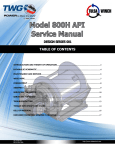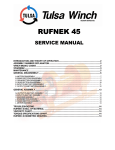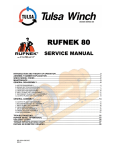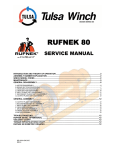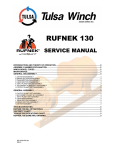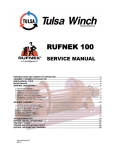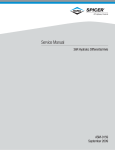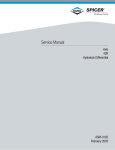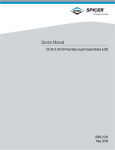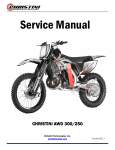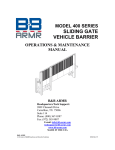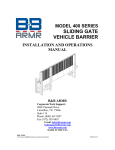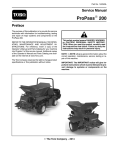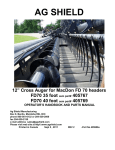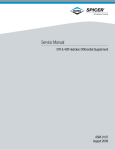Download RN30W Service Manual
Transcript
DESIGN SERIES 001 RUFNEK 30 AND MODEL 34 SERVICE MANUAL GENERAL INFORMATION .......................................................................................................................... 4 INTRODUCTION AND THEORY OF OPERATION .............................................................................................................4 ASSEMBLY NUMBER EXPLANATION ...............................................................................................................................4 WINCH BREAK-IN ..............................................................................................................................................................4 MODEL CODES ........................................................................................................................................... 5 MAINTENANCE............................................................................................................................................ 6 OIL LEVELS........................................................................................................................................................................7 BRAKE ADJUSTMENT .......................................................................................................................................................8 DISASSEMBLY ............................................................................................................................................ 9 RUFNEK 30 BRAKE DISASSEMBLY..................................................................................................................................9 MODEL 34 BRAKE DISASSEMBLY....................................................................................................................................10 CLUTCH AND DRUM DISASSEMBLY................................................................................................................................11 GEARBOX DISASSEMBLY.................................................................................................................................................12 GEAR INSPECTION INSTRUCTIONS ................................................................................................................................13 ASSEMBLY ................................................................................................................................................ 14 GEARBOX ASSEMBLY ......................................................................................................................................................14 MODEL 34 BRAKE ASSEMBLY..........................................................................................................................................15 RUFNEK 30 BRAKE ASSEMBLY........................................................................................................................................15 CLUTCH AND DRUM ASSEMBLY......................................................................................................................................16 TROUBLESHOOTING................................................................................................................................ 17 BILL OF MATERIAL................................................................................................................................... 18 TORQUE SPECIFICATIONS CHART ........................................................................................................ 19 CLUTCH INSPECTION .............................................................................................................................. 19 ISOMETRIC VIEW ...................................................................................................................................... 19 RUFNEK BRAKE, HYDRAULIC MOTOR, & CLUTCH POSITION INDICATOR...................................... 19 SEL-0046-001.DOC REV-0 FAILURE TO HEED THE FOLLOWING WARNINGS MAY RESULT IN SERIOUS INJURY OR DEATH. The safety of the winch operator and ground personnel should always be of great concern, and all necessary precautions to insure their safety must be taken. The primary mover and the winch must be operated with care and concern for the equipment and the environment and with a thorough knowledge of the equipment and its performance capabilities must be understood. These general safety guidelines are offered, however local rules and regulations or national standards may also apply. Recommended references are, but not limited to, ANSI B30, OSHA 1910, AWS D 14.3, and SAE J706. Additional information can be found at http://www.team-twg.com/TulsaWinch/ Indicates an imminently hazardous situation which, if not avoided, will result in death or serious injury. Indicates a potentially hazardous situation which, if not avoided, could result in death or serious injury. Indicates a potentially hazardous situation which, if not avoided, may result in minor or moderate injury or property damage. Indicates information or a company policy that relates directly or indirectly to the safety of personnel or protection of property. Mounting: Winch mounting must be secure and able to withstand the applied loads. • • • • The stability of the mounting system must be approved by a qualified person. All welding should also be done by a qualified person. Winch mount must be flat so as not to induce binding. The flatness must not exceed 1/16 inch across the mounting surface of the winch itself. Guards must be placed on all open drives in the case of mechanical winches. Insure that all hydraulic hoses, valves and fittings are rated to winch manufacturer’s operating pressures. Relief valves should be set to winch manufacturer’s specifications. Insure that all PTO’s and drivelines are sized appropriately for the winch manufactures speed and torque specifications. 2 Operator: Must read and understand the operating and service manual. Both the SERVICE MANUAL and OPERATING AND MAINTENANCE MANUAL are available online at http://www.team-twg.com/TulsaWinch/ Must never lift or move people with this winch. This winch is not designed or intended for any use that involves moving people. Must stay clear of the load at all times. Ground personnel should remain a safe distance from the load and winch cable at least 1 ½ times the length of cable measured from the winch to the load. Must stay clear of the cable at all times. A broken cable can cause serious injury or death. Must avoid shock loads. Shock loads can impose a strain on the winch that can be many times the design rating. Must be aware of the fleet angle of the winch. All loads should only be pulled with the load line perpendicular to the drum shaft, this is to avoid excessive stresses on the winch and will help prevent the cable from building on one side of the drum flange. Must wear personnel protective equipment (PPE) if required. Check the local, state and federal regulations for compliance. Must insure that the drum clutch is fully engaged before hoisting. A visual inspection of the drum clutch engagement is required before each winching operation. Must rig all loads secure before winching. Pull the load line taut and inspect the condition of load for stability. Must inspect the drum brake if equipped. The drum brake is not a load holding device it is design to prevent over spooling of the drum and causing bird nesting of the cable on the drum. Inspect the brake for wear of the lining and the actuation method. Must inspect the load control brake. These winches can be equipped with two (2) forms of dynamic braking. The worm brake is one method and is adjustable for pay-out load control. Before a load is handled the load should be pulled tight and stopped to check this brake. The second method is a hydraulic lowering control that is not field adjustable. The same method should be used to check this brake. Operation: • • • • • • All winch controls must be well marked for function to avoid confusion. Insure that the PTO is disengaged when the winch is not in use. All winch controls must be located to provide the operator with a clear view of the load. The clutch must be inspected daily for proper operation. The winch cable should be inspected daily for serviceability. A minimum of five wraps of tightly wound cable must remain on the drum. 3 GENERAL INFORMATION INTRODUCTION AND THEORY OF OPERATION The Tulsa worm gear winch is operated by turning the input of the worm using a hydraulic motor or PTO driven sprocket and chain. The winch utilizes the adjustable, spring applied, multiple disc oil brake that activates only during pay-out to provide maximum efficiency during pay-in. The torque is transferred from the gearbox through the drum shaft which is keyed to a mechanically actuated sliding clutch that when engaged transfers the torque to the drum. ASSEMBLY NUMBER EXPLANATION This manual is for design series 001. In the case of a major design change implementation, a new design series designation number will be issued for the winch. A new manual will also be created for that specific design series. ASSEMBLY # DESIGN SERIES 69216 001 WINCH BREAKBREAK-IN Winches, like any other kind of machinery, require a “break-in” to perform well and to maximize their life. The following guidelines should be used in the break-in of Tulsa Winches. Use extreme care when first spooling cable onto the winch. DO NOT run the winch at high speeds when performing this operation. Make sure that the cable is payed-out in a straight line (to prevent kinks) and SLOWLY pay-in the winch to install the cable. DO NOT exceed one half rated load or one half rated line speed for the first thirty minutes of operation. This will insure that the worm and gear have an opportunity to wear in properly. Periodically, check the gearbox for temperature rises and allow the winch to cool down between pulls. Worm gear winches are designed and intended for intermittent duty application only; using them in extremely long pulls may generate excessive heat and shorten the life of the winch. 4 MODEL CODES RN30 WM R F O M X Motor Type 1. Single Speed Gear Motor 2. Two Speed Gear Motor 3. Single Speed Geroler Motor 4. Two Speed Geroler Motor 5. Piston 6. Vane X. No Motor Gear Type W=Worm P=Planetary Drive Type H=Hydraulic M=Mechanical Gearbox Position L=Left R=Right (viewed from rear of truck) Input Shaft Location F=Front R=Rear X=Does not apply (viewed from rear of truck) M34 THE RUFNEK 30 SERIES WINCHES ARE ONLY AVAILABLE WITH LEFT HAND GEARS. Clutch Device M=Mechanical A=Air Cable Spooling O=Over Drum U=Under Drum (viewed from rear of truck) S L R F O D CL Motor Type CL-CharLynn Winch Type M=Mechanical H=Hydraulic G=Speed Reducer No. of Worm Starts S=Single D=Double T=Triple Worm Angle L=Left R=Right Gearbox Location L=Left R=Right (viewed from rear of truck) Motor Mount D=Direct Mount X=No Motor Cable Spooling O=Over Drum U=Under Drum (viewed from rear of truck) Input Shaft Location F=Front R=Rear X=Does not apply (viewed from rear of truck) 5 MAINTENANCE Tulsa Winch worm gear winches require regular maintenance to ensure safe and reliable operation. Regular oil changes with the correct oil for the ambient temperature conditions and an annual inspection of the wear components are strongly recommended. Maintenance Scheduling The owner is to ensure proper inspection intervals, in compliance with the API RP 2D Section 4, ANSI B30.5, 5-2.3, or ANSI B30.7, 7-2.1, and will review winch usage categories on a periodic basis. A qualified inspector should perform all maintenance and inspections. USE (HRS PER MONTH) 0-10 11-50 51+ API RP 2D RECOMMENDED INSPECTION SCHEDULE PRE-USE, ANNUAL PRE-USE, QUARTERLY PRE-USE, MONTHLY Oil Maintenance The oil in the gear and brake section should be changed every 1000 hrs or 6 months of normal usage. • Tulsa Winch recommends that the oil level in the gearbox be checked and adjusted as part of the pre-use inspection. If the oil level drops frequently or oil leakage is detected during an inspection, maintenance should be performed to correct any problems. GEARBOX OIL CAPACITY = 3 QTS • Gearbox oil level inspection is achieved by removing the oil level inspection plug and visually inspecting the oil level. Minimum oil level is to the bottom of the threads of the inspection hole. Refer to the chart below for the recommended oil type and grade for your application. SAE 140W AGMA 7 EP MOBIL SHC 626 MOBILUBE HD80W140 All oils must meet MIL-PRF2105E standards. Substitution from a reputable manufacturer is allowed as long as type and grade are maintained. 6 OIL LEVELS GEARBOX FILL/VENT GEARBOX OIL LEVEL GEARBOX OIL DRAIN BRAKE FILL/VENT BRAKE OIL DRAIN BRAKE OIL LEVEL 7 BRAKE ADJUSTMENT In general, worm brakes on Tulsa winches should be set to hold the load you are currently working with. Excessive brake torque will result in excessive heat generation and brake wear. The best way to insure proper brake adjustment is to pull the cable tight against the load and stop to ensure the brake holds. If it doesn’t, tighten the brake slightly and try it again. If the brake doesn’t respond to adjustment the brake must be serviced. If the input to the winch is accessible and a torque wrench can be adapted to it, the brake can be set with a torque wrench. The Model 34 brake is shipped from the factory pre-set at 70 Ft.-Lbs. ADJUSTABLE SHOE BRAKE To tighten the brake, loosen the two capscrews in the slotted holes and rotate the brake in the direction shown. If the brake needs to be reversed, remove those same two capscrews, rotate the cam 60 degrees and reinstall the capscrews in the other set of holes which have just been revealed. After adjustment, be sure to re-tighten the cam capscrews securely. ADJUSTABLE MULTIPLE DISC OIL BRAKE RN30W This style of brake can be adjusted by turning the hex adjuster counter-clockwise to increase brake and clockwise to decrease brake. The direction of braking for all multiple disc brakes can be changed by removing the cam clutch, turning it over, and reinstalling it. For detailed service instructions, contact your Tulsa Winch distributor or the factory. If the input to the winch is accessible and a torque wrench can be adapted to it, the brake can be set with a torque wrench. The RN30W brake is shipped from the factory pre-set at 70 Ft.-Lbs. 8 DISASSEMBLY RUFNEK 30 BRAKE DISASSEMBLY 1. Remove the bottom drain plug (100) to drain oil from brake. 5. Inspect parts as follows, replace if necessary: 2. Loosen the spring tension inside the brake by rotating the adjusting nut (97) clockwise until it stops. A. Inspect the friction discs (104) for uneven or excessive wear. Friction discs should measure no less than .055-in thick. B. Inspect the stator plates (103) for warpage or excessive damage. Extreme care should be taken when removing the brake cover. The cover is spring loaded against the cover screws. C. Inspect the spring (105) damage or discoloration. 3. Evenly remove the capscrews (94) from the brake cover (96). for D. Cam clutch (107) should be free of debris and have all cams intact. 4. Remove the spring (105). Remove the brake driver (101) along with the brake components (93, 103, 104, 106, and 107). If replacing the cam clutch (107), take note of the direction it locks up for reassembly. E. Check coupler (108) for signs of pitting, spalling, or excessive wear. 9 MODEL 34 BRAKE DISASSEMBLY 1. Loosen the capscrews (26). 7. Inspect parts as follows, replace if necessary: 2. Remove the capscrews (30) from the cover (87). A. Inspect the brake shoes (86) for wear. If the shoe linings are worn flush with the rivet heads, they must be replaced. 3. Remove the cover (87) from the brake housing (31). 4. Remove the brake shoes (86). B. Inspect the brake drum (83) for severe wear or scoring. 5. Remove the nut (85) and washer (84). C. Check the inside lower part of the brake housing (31) for the presence of oil. Replace the seal (55) if oil is present. 6. Use the two threaded holes in the brake drum (83) and a gear puller to remove the brake drum. If replacing the seal (55), first drain the oil from the gearbox then remove the capscrews (56) and brake housing (31). 10 CLUTCH AND DRUM DISASSEMBLY 1. Remove the rod (44) by removing the cotter keys (43). and nuts (24) attaching the brake band to the frame. 2. Remove the arms (34) by removing the capscrews (46), nuts (24), and washers (23) holding the arm in place. 9. Slide the drum (14) off of the output shaft (68) using an overhead hoist. 10. Inspect parts as follows, replace if necessary: 3. Remove the line shafts (35) by loosening the set screws in the collars (38) and the setscrews (42) in the arms (45) & (27). A. Inspect the bushing (2) in the end bracket (6) for excessive wear. B. Inspect the keys (67), sliding clutch (11), and collar (10) for damage. See page 22 for clutch inspection. 4. Remove the capscrews (59), nuts (63), and washers (62) attaching the end bracket (6) to the frames (65 & 66). C. Inspect the brake band (8) and verify the band and lining is at least .225-in thick. 5. Remove the end cap (5) by removing the four capscrews (3), nuts (20), and washers (19). D. Inspect the drum bushings (60) for wear or damage. 6. Remove the end bracket (57), yoke assembly (items 7, 16, 19, 20, 39, 40, 41) or clutch position indicator assembly (109), and sliding clutch (55). E. Inspect the line shafts & linkage for excessive damage or wear. 7. Remove the keys (67) and collar (10) from the shaft (68) by loosening set screw (9). 8. Remove the brake band assembly (8) by loosening the nuts on the rod (21) to remove tension on the spring (22). Then, remove the cotter key (32) & pin (33) attaching clevis (28) to control arm (27). Finally, remove the capscrews (16), washers (23), 11 GEARBOX GEARBOX DISASSEMBLY 1. Supporting the end of the shaft (68), remove the cover (76) by removing capscrews (46 and 78), nuts (20 and 24), and washers (19 and 23). 5. From the brake end, push the worm (57) out of the housing (61). If the brake has not been removed, see brake disassembly on page 9 or 10. 2. Lift the shaft (68), bushings (69), keys (70), and gear (assembled items 71, 72, 73, 74, 75, 80, and 81) out of the housing (61). Remove the bushings (69) from the shaft (68). 6. Inspect parts as follows, replace if necessary:: 3. Remove the gear (75) from the carriers (72) by removing the twelve capscrews (71), nuts (81), and washers (80), then pull the carrier (72) off of the shaft (68). Finally, remove the spacer (73), carrier (72) and keys (70). B. Inspect the gear (75) for excessive wear or damage. See page 13 for detailed instructions. A. Inspect the damage. carriers (72) C. Inspect the keys (70) bushings (69) for damage. for and D. Inspect the worm (57) for excessive wear or signs of heat checking or cracks. 4. Remove the worm (57) from the housing (61) by removing either the motor (116) and motor adapter (112), or just the end cap (51), depending on the type of drive. E. Inspect the bearings (54) and seals (55) for excessive wear or damage. 12 GEAR INSPECTION INSTRUCTIONS LAND Check gear wear by removing the cover and visually inspecting the bronze gear. If the gear is worn such that there is no visible land on the throat of the gear between the gear flanks as shown in picture above the gear should be replaced. 13 ASSEMBLY GEARBOX GEARBOX ASSEMBLY 1. Press the bearings (54) onto the worm (57) then install the worm and bearings into the housing (61). 4. Slide the carrier (72) over the keys (70). Install the spacer (73) using the two pins (74). Slide the gear (75) and the other carrier (72) onto the shaft and secure with eighteen capscrews (71), nuts (81), and washers (80). 2. For winches driven by a hydraulic motor: Press a new oil seal (55) into the motor adapter (112). Install the gasket (52). Attach the motor adapter (112) to the housing (61) with six capscrews (89) using gasket (52). Install the motor (116) with two capscrews (114) and washers (115), using gasket (113). 5. Install the assembled gear onto the shaft (68). Slide the bushings (69) on to both ends of the shaft (68). 6. Install the output shaft assembly into the housing (76). For winches driven by a PTO sprocket and chain: Press a new oil seal (55) into the end cap (51). Attach the end cap (51) to the housing (61) with six capscrews (56) using gasket (52). 7. Install both gaskets (79) onto the housing. Attach the cover (76) to the housing (61), using capscrews (46 & 78), nuts (19 & 20), washers (19 & 23), using gaskets (79). 8. Fill the gearbox and brake with the proper oil. Refer to the maintenance section of this manual for correct oil type and amount. 3. Install the keys (58) into the output shaft (68). 14 MODEL 34 BRAKE ASSEMBLY 1. Press the oil seal (55) into the brake housing (31). Attach the brake housing (31) to the gearbox with six capscrews (56) using gasket (52). 2. Install the brake drum (83) and key (82) onto the worm shaft (57). Secure the brake drum with the nut (85) using the lock washer (84). Bend two tabs of the washer (84) over the flats of the nut (85). 4. Install the brake cover (87), cam (53), and brake shoes (86) into the brake housing (31). 3. If removed, reattach the cam (53) to the brake cover (87) in the orientation needed for your application using two capscrews (26) and washers (29). 5. Secure the brake cover (31) using four capscrews (30). 6. Adjust the brake using the procedure on page 8 of this manual. RUFNEK 30 BRAKE ASSEMBLY 1. Press the oil seal (90) into the brake housing (91). Attach the brake housing to the gearbox with eight capscrews (89) using gasket (110). 4. Install the spring (105). 5. Install the adjusting nut assembly (assembled items 97, 98, and 99) into the brake cover (96) and attach the brake cover to the housing (91) with eight evenly installed capscrews (94). 2. Install the key (92) and coupler (108) onto the worm. Next, install the clutch/driver assembly (Items 93, 101, 106, and 107), onto the coupler (108). 6. Install the drain plug (100) into the bottom of the brake cover (96). 3. With the retaining ring (93) on the clutch driver (101). Install the stator plates (104) and friction discs (103), as shown below. 7. Fill gearbox and brake with proper oil. Refer to winch maintenance section of this manual for oil type and amounts. 8. Adjust the brake using the procedure on page 8 of this manual. 15 CLUTCH AND DRUM ASSEMBLY 1. Install bushings (60) into drum (14). Install the drum (14) onto the output shaft (68). 3. Install the sliding clutch (11) and end bracket assembly onto the shaft (68), lining up the yoke with the grooves in the sliding clutch (11). Attach the end bracket to the frame using four capscrews (59), washers (62), and nuts (63). 2. Install the collar (10). Tap the keys (67) into the output shaft. CLUTCH POSITION INDICATOR ADJUSTMENT (FOR RUFNEK WINCHES ONLY) Make sure that the sliding clutch (11) is fully engaged and that the yoke assembly (111) is not binding on the drum clutch. The lugs of the yoke MUST be centered in the groove with the clutch fully engaged in order for the clutch position indicator to be properly adjusted (See FIG-1). The switch is a normally-open electrical switch that is actuated by disengaging the clutch which closes the circuit. With the clutch fully engaged, adjust the switch in until the warning device is activated, then back-out 1/4 turn to deactivate the warning device. Tighten the jam nut against the clutch bracket to secure the adjustment. Test the switch by fully engaging, then disengaging, the clutch. The warning device should activate while disengaging the clutch pivoting no more than 3°. FIG.-2 FIG.-1 11 111 NUT SWITCH 16 TROUBLESHOOTING FAILURE Clutch handle won’t latch Oil leaks from housing PROBABLE CAUSE a) Clutch jaws aren’t aligned. Align the jaws by rotating drum. b) Damaged yoke or linkage. Replace the yoke or clutch a) Seal damaged or worn. Replace the seal(s). b) Too much gearbox oil. oil. Load drifts Winch runs too slow Cable drum won’t free spool Drain excess c) Gasket is worn. Replace gasket. a) The brake is out of adjustment or worn. Adjust brake until load doesn’t drift. Replace the parts as required. a) Low flow rate. Check the flow rate and increase if necessary. b) Hydraulic motor worn out. Replace the motor. a) Winch not mounted squarely. Check mounting and confirm that the winch is mounted on a level surface. b) Clutch not disengaged. Disengage the clutch. Hydraulic fluid leaks from the vent in a) Damaged motor shaft seal. Replace the gearbox the seal. Winch won’t pick up heavy loads. a) Too much cable on the drum. Use the snatch block or remove some cable from the drum. b) System pressure too low. Increase the hydraulic system pressure. c) Winch not broke-in. Run winch at half of rated load for several pulls. 17 BILL OF MATERIAL BOM DATED SEPTEMBER 2005 SEQ QTY P/N DESCRIPTION 1 2 3 4 5 6 7 8 9 10 11 12 13 14 15 16 17 18 19 20 21 22 23 24 25 26 27 28 29 30 31 32 33 34 35 36 37 38 39 40 41 3 1 4 5 1 1 1 1 2 2 1 1 6 1 1 5 --8 9 5 1 16 15 1 2 1 1 4 4 1 1 1 2 2 -4 4 1 2 1 20517 32842 20266 21128 20053 20256 20129 1741 20515 20096 20262 23598 20407 23595 21154 20270 --20518 20267 20521 20958 20526 20271 20112 20522 20094 20054 20617 28578 21365 20514 939243 20070 20282 -20193 20230 20264 24724 20116 PIN BUSHING CAPSCREW GREASE ZERK END CAP BRACKET BRACKET BRAKE BAND ASSEMBLY SET SCREW WASHER SLIDING CLUTCH DRUM CLUTCH CAPSCREW DRUM U BOLT CAPSCREW OMIT OMIT LOCKWASHER NUT NUT SPRING LOCKWASHER NUT ROD CAPSCREW ARM CLEVIS WASHER CAPSCREW HOUSING COTTER PIN CLEVIS PIN ARM SHAFT OMIT SET SCREW COLLAR YOKE SNAP RING PIN 18 BILL OF MATERIAL CONTINUED SEQ 42 43 44a 44b 45 46 47 48 49 50 51 52 53 54 55 56 57a 57b 57c 57d 58 59 60 61 62 63 64 65 66 67 68 69 70 71 72 73 74 75a 75b 76a 76b 77 QTY 2 2 1 1 1 10 1 4 1 1 1 2 1 2 2 16 1 1 1 1 1 8 2 1 8 8 3 1 1 2 1 2 2 10 2 1 2 1 1 1 1 1 P/N 20737 20474 20111 20113 20072 20276 20284 20105 20278 20092 21542 20118 23875 20303 20281 30205 21641 21640 44068 44070 25393 939262 32840 21556 20520 20274 20286 939269 20293 20098 22443 32839 20574 21157 22438 20569 164056 21643 21642 20127 44030 26799 DESCRIPTION SET SCREW COTTER PIN RIGHT HAND ROD LEFT HAND ROD ARM CAPSCREW BRACKET KEY CAPSCREW WASHER CAP GASKET CAM BEARING OIL SEAL CAPSCREW RIGHT HAND WORM (M34) LEFT HAND WORM (M34) MECHANICAL WORM (RN30) HYDRAULIC WORM (RN30) KEY CAPSCREW BUSHING HOUSING LOCKWASHER NUT PIPE PLUG LEFT FRAME RIGHT FRAME KEY SHAFT BUSHING KEY CAPSCREW CARRIER SPACER PIN RIGHT HAND GEAR LEFT HAND GEAR MODEL 34 COVER RUFNEK 30 COVER BREATHER 19 BILL OF MATERIAL CONTINUED SEQ 78 79 80 81 82 83 84 85 86 87 88 89 90 91 92 93 94 95 96 97 98 99 100 101 102 103 104 105 106 107 108 109 110 111 112 113 114 115 116 117 QTY 4 2 10 10 1 1 1 1 2 1 1 16 1 1 1 1 8 1 1 1 1 1 2 1 1 6 11 1 1 1 1 1 1 1 1 1 2 2 1 1 P/N 20268 20326 20519 20273 20279 29503 20115 20114 1733 3568 43962 40546 44050 43964 25519 44151 20522 13050 43966 41406 43960 41411 21684 44150 44145 33564 44141 33559 29084 33565 44142 12208 20118 4362 40432 40147 13529 41000 40275 996547 DESCRIPTION CAPSCREW GASKET LOCKWASHER NUT KEY BRAKE DRUM LOCKWASHER LOCK NUT BRAKE SHOE CAM PLATE BRAKE HOUSING CAPSCREW OIL SEAL BRAKE HOUSING KEY O-RING CAPSCREW BREATHER BRAKE COVER ADJUSTING NUT SPRING PLATE O-RING PLUG BRAKE DRIVER RETAINING RING FRICTION DISC STATOR PLATE SPRING RETAINING RING CAM CLUTCH COUPLER BUSHING GASKET YOKE ASSEMBLY W/ POSITION INDICATOR MOTOR ADAPTER GASKET CAPSCREW WASHER MOTOR OIL SEAL 20 TORQUE SPECIFICATIONS SPECIFICATIONS CHART Dry SAE Grade 5 Torque *(FtLbs) Plated SAE Grade 5 Lubricated SAE Grade 5 Torque *(Ft-Lbs) Torque *(Ft-Lbs) Dry SAE Grade 8 Torque *(FtLbs) Plated Lubricated SAE SAE Grade 8 Grade 8 Torque Torque *(Ft*(Ft-Lbs) Lbs) Nominal Size 1/4 20 8 6 5 12 9 7 1/4 28 10 7 6 14 10 8 5/16 18 17 13 10 25 18 15 5/16 24 19 14 11 27 20 16 3/8 16 31 23 19 44 33 26 3/8 24 35 26 21 49 37 30 7/16 14 49 37 30 70 53 42 7/16 20 55 41 33 78 58 47 1/2 13 76 57 45 106 80 64 1/2 20 85 64 51 120 90 72 9/16 12 109 82 65 153 115 92 9/16 18 122 91 73 172 129 103 5/8 11 150 113 90 212 159 127 5/8 18 170 128 102 240 180 144 3/4 10 266 200 160 376 282 226 3/4 16 297 223 178 420 315 252 7/8 9 430 322 258 606 454 364 7/8 14 474 355 284 668 501 401 1 1 8 644 483 386 909 682 545 14 721 541 433 1019 764 611 1-1/8 7 794 596 475 1288 966 772 1-1/8 12 890 668 534 1444 1083 866 1-1/4 1-1/4 7 12 1120 1241 840 930 672 745 1817 2012 1363 1509 1090 1207 T = BOLT TORQUE (LB. FT.) T = (KWD) / 12 K = TORQUE COEFFICIENT (K = 0.20 DRY K = 0.15 PLATED K = 0.12 LUBRICATED) W = PRELOAD TENSION D = NOMINAL BOLT SIZE (IN.) * ALL TORQUE VALUE TOLERANCES ARE ± 5% 21 CLUTCH INSPECTION 22 ISOMETRIC VIEW FOR RUFNEK BRAKE AND HYDRAULIC MOTOR, SEE PAGE 24 23 RUFNEK BRAKE, HYDRAULIC MOTOR, & CLUTCH POSITION INDICATOR RUFNEK OIL BRAKE CLUTCH POSITION INDICATOR KIT HYDRAULIC MOTOR VIEW 24


























